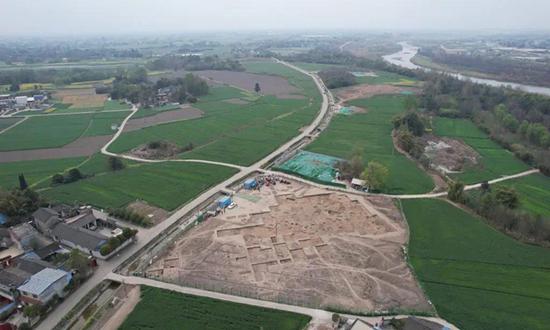3,400-year-old jade and stone workshop site discovered at Sanxingdui Ruins
New discoveries shed light on ancient Shu civilization
Chinese archaeologists have uncovered a jade and stone processing site that dates back over 3,400 years at the legendary Sanxingdui Ruins in Southwest China's Sichuan Province, according to Xinhua News Agency on Tuesday.
The newly unearthed artifacts at the site include blanks, waste, fragments and finished products - evidence of a relatively complete early handicraft production chain. Preliminary assessments suggest that the site was a jade and stone workshop.
The workshop was located in a protected open space, approximately one kilometer north of previously unearthed sacrificial pits.
This is the first time a handicraft workshop has been discovered at Sanxingdui. The new findings will help archaeologists verify the sources of raw materials for Sanxingdui's jade and stone artifacts and address questions about the functional layout of the ancient city. It marks an important step in Sanxingdui archaeological research, researchers said.
China's Sanxingdui Ruins site has already brought tremendous treasures to the world with over 60,000 artifacts unearthed and hosting 5 million visitors from all around the world. The new discoveries and restoration of artifacts have brought unexpected surprise, shedding light on the origins of previously unearthed cultural relics and the ancient Shu civilization.
From 2022 to 2024, Chinese archaeologists discovered remnants related to the production and processing of jade and stone artifacts at the site. Experts preliminarily identified these remains as evidence of a jade and stone artifact "production workshop" dating back to the middle Shang Dynasty (c.1600BC-1046BC), predating the burial period of Sanxingdui sacrificial pits.
Since 2022, experts have conducted archaeological exploration, uncovering more than 400 high-grade architectural foundations, ash pits, ash ditches, stone artifact production and processing sites. They have unearthed more than 4,000 pieces of pottery, jade, and stone artifacts.
Recent discoveries at a building foundation site also indicates that over 3,000 years ago, the ancient city of Sanxingdui already had clear urban planning. Although parts of the site's city wall were destroyed throughout history, archaeologists have been able to reconstruct the basic layout of the ancient city site based on surveys of the remaining sections. The Sanxingdui ancient city site covers an area of approximately 3.6 square kilometers and is oriented northwest-southeast.
This orientation is consistent with the previously discovered high-grade building foundations and newly discovered jade and stone workshops.
Xu Danyang, a deputy head of the Sanxingdui site of the Sichuan provincial cultural relics and archaeology research institute, mentioned that the orientation of the artifacts within the pits is also consistent with the overall orientation of the Sanxingdui ancient city, according to Xinhua.
These new archaeological discoveries, along with the newly confirmed water gates and city gates, have provided valuable data for the in-depth study of the urban layout of the Sanxingdui ancient city.
Even more discoveries have been made. Archaeologists have always been dedicated to restoring a better picture of the ruins.
Over 17,000 numbered artifacts have been unearthed from Sacrificial Pits 3 to 8 at the Sanxingdui site, including more than 4,500 relatively complete items. These artifacts suffer from various issues such as damage, corrosion and fractures, making their conservation and restoration a formidable task. As of June, over 4,000 artifacts have undergone cleaning and conservation.
The conservation and restoration achievements include over 50 representative items exhibited such as bronze, gold, jade and ivory artifacts. The No.2 Bronze Sacred Tree from the Sanxingdui Ruins, standing nearly 2.88 meters, has also been digitally restored, according to the People's Daily on Tuesday.
Located in Guanghan, the Sanxingdui Ruins unveil the historical culture of the ancient Shu civilization, providing substantial evidence of the diverse unity of Chinese civilization and offering a window for the world to appreciate Asian culture. It has been hailed as one of the world's most significant archaeological finds of the 20th century.
Ran Honglin, head of the archaeological team at the Sanxingdui Ruins, once told the Global Times that many bronzes and jades related to sacrificial activities at the ruins are unique in China and even the world. "The number of unearthed cultural relics will keep increasing with further work," Ran noted.
According to Xinhua, future efforts will seek to locate bronze production workshops and further uncover the mysteries of the ancient Shu civilization, providing stronger evidence for the diverse unity of Chinese civilization.

